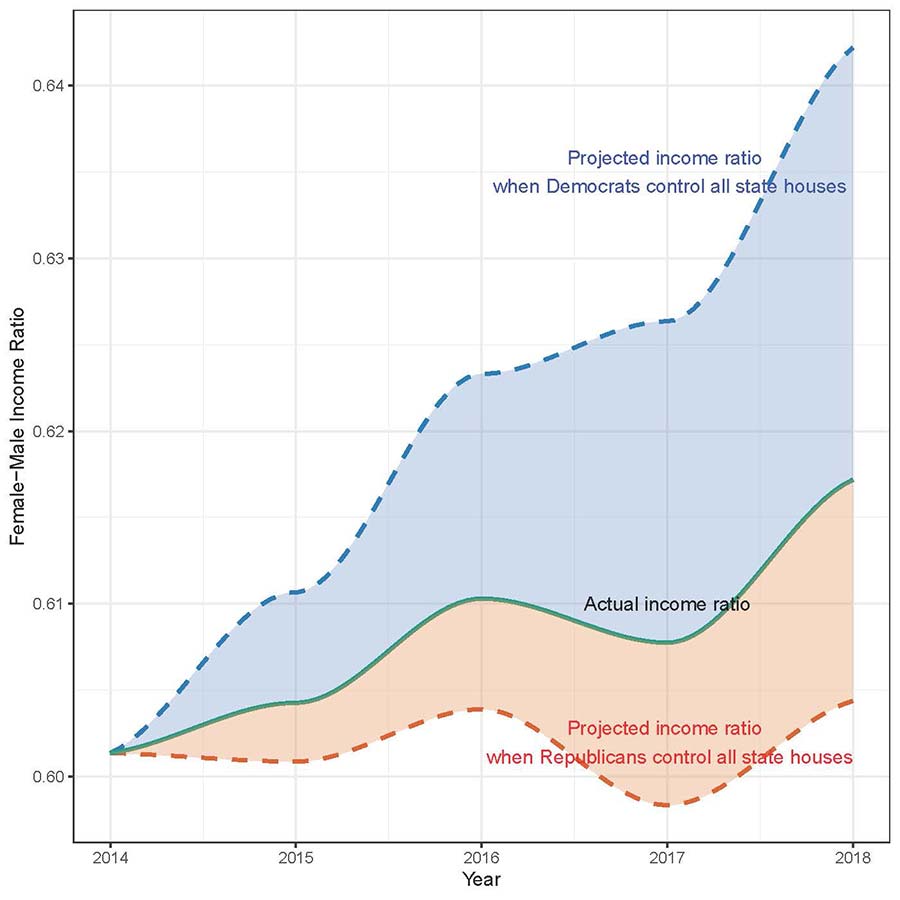University of California San Diego News
In an increasingly polarized political system, Democratic control has a meaningful impact on narrowing the gender gap
October 8, 2020 — New research from the University of California San Diego reveals that Democratic control of state houses leads to substantial improvement in women’s incomes, wages and unemployment relative to men.
The study, to be published in Legislative Studies Quarterly, finds that especially in the recent period of pronounced partisan polarization, Democratic house control helps close the gender inequality gap. Across all states, women’s wages averaged only 70 percent of men’s wages in 2018, but just a few years after Democrats are elected in a state, that gap typically declines by 3.6 percentage points. Additionally, the researchers estimate that a slim Democratic majority in the house — as opposed to a slim Republican majority—leads to a 2.6 percent point reduction in the overall income gap between men and women.
“No voting bloc is more important in American elections than women,” said first author Zoltan Hajnal, a professor of political scientist at UC San Diego’s School of Global Policy and Strategy. “With women accounting for more than half of all votes, small shifts in the female vote can and likely will determine who wins in November.”
Hajnal and co-author John Seungmin Kuk of the University of Oklahoma also assessed whether Democratic or Republican control of the White House could be linked to gains or declines in gender inequality, and the same pattern emerged.

Over the last half century, women’s incomes grew almost twice as fast under Democratic administrations than they did when Republicans held the Oval Office. The average gain in income for women was $443 per year under Democrats but only $284 per year under Republicans. And, poverty as well as unemployment rates also fell among females under Democratic administrations.
To test whether Democratic or Republican control of state houses impacts gender inequality, the authors tracked male and female wages, income, poverty, and employment in each state annually for the last five decades. Specifically, they looked to see if women were catching up to men faster when Democrats controlled the levers of state power then when Republicans did.
Their assessment was made by comparing changes in gender equality in states where Democrats barely won a majority in the House to states where Republicans barely won a majority. Further comparisons revealed that that Democratic control of the state House leads to significant improvement in female income (relative to male income), significant declines in female unemployment (relative to male unemployment), and near significant declines in the wage and poverty gaps.
“Just one year of Democratic control leads to a one percentage point increase in the female-male income ratio, a 0.7 percentage point decline in the wage gap, a 0.4 percent decline in the female-male employment gap, and a .28 percent decline in the male-female poverty gap,” the authors wrote.
A gender gap that is no longer narrowing

These trends could be critical in closing the gender wage gap. The study points to ample evidence that women who work in the same job with the same level of experience still get paid considerably less than men. For example, National Women’s Law Center recently estimated that women typically have to work 50 years to make what a man earns in 40 years. Moreover, there is evidence that after declining for many decades, the gap is no longer narrowing.
Several factors contribute to pronounced inequity, such as the fact that women are much more likely than men to be family caregivers means that the gender gap widens after women become mothers. However, 38 percent of the gender wage gap cannot be explained by factors that are easily measured such as occupation, educational attainment, or years of experience.
So, what do Democrats do differently to help close the gender the gap?
While the researchers could not definitively answer this question, they find two factors are associated with the gains for women under Democrats.
“The first is gender policy,” they write. “Democratic control of the state houses leads to significantly more liberal policies on gender discrimination and access to family planning. The other factor is female representation. We find that having more women in office also leads to more liberal gender policy and likely contributes to improvement on basic economic indicators for women.”
However, just having more women hold office isn’t necessarily the answer, according to the data.
“Any impact of female legislators is entirely contingent on having Democrats control the house majority,” they write. “Having women in office greatly matters for gender policy, but only when Democrats control the agenda.”

While Democratic vs. Republican control has meaningful effects for gender equality in some cases, it does not in others. Partisan control of the governor’s office appears to have no clear impact on gender equality, and the same could be inferred regarding state senates. Data limitations prevented the authors from directly assessing the effect of Democratic control of the state senate, but their exploratory analysis revealed no clear effects.
Yet, they conclude that parties appear to have more meaning now as polarization has increased, relative to how a less-divided political system operated for much of the 20th Century.












